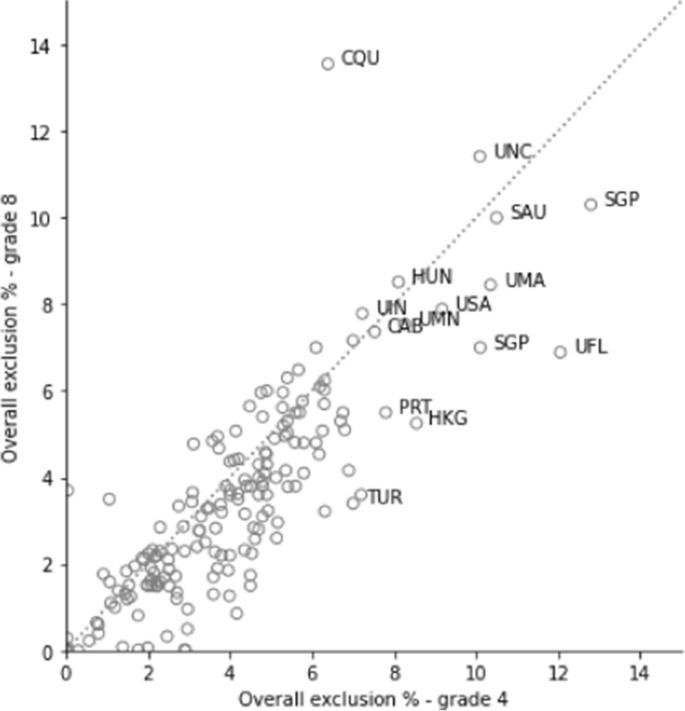国际大规模评估的排除率:对国际能源署20年数据的分析
IF 1.6
3区 教育学
Q1 EDUCATION & EDUCATIONAL RESEARCH
Educational Assessment Evaluation and Accountability
Pub Date : 2023-09-21
DOI:10.1007/s11092-023-09416-3
引用次数: 0
摘要
教育成就的跨国比较依赖于每个参与国收集具有全国代表性的数据。虽然获得高回复率是实现这一目标的关键部分,但其他潜在的重要因素也可能在起作用。本文关注的是一个这样的问题——排他率——这在学术文献中受到的关注相对较少。使用20年来国际大规模评估数据的数据,我们发现各国的排斥率存在适度变化,并且随着时间的推移,排斥率有相对较小的增长。我们还证明了小学生的排斥率往往高于中学生的排斥率。最后,虽然排除率和反应率之间似乎没有什么关系,但排除水平和测试成绩之间存在微弱的负相关。最后,我们讨论了如何向非专业观众更清楚地传达有关排除的信息以及其他类似问题。本文章由计算机程序翻译,如有差异,请以英文原文为准。

Exclusion rates from international large-scale assessments: an analysis of 20 years of IEA data
Abstract Cross-national comparisons of educational achievement rely upon each participating country collecting nationally representative data. While obtaining high response rates is a key part of reaching this goal, other potentially important factors may also be at play. This paper focuses on one such issue—exclusion rates—which has received relatively little attention in the academic literature. Using data from 20 years of international large-scale assessment data, we find there to be modest variation in exclusion rates across countries and that there has been a relatively small increase in exclusion rates in some over time. We also demonstrate how exclusion rates tend to be higher in studies of primary students than in studies of secondary students. Finally, while there seems to be little relationship between exclusion rates and response rates, there is a weak negative association between the level of exclusions and test performance. We conclude by discussing how information about exclusions—and other similar issues—might be more clearly communicated to non-specialist audiences.
求助全文
通过发布文献求助,成功后即可免费获取论文全文。
去求助
来源期刊

Educational Assessment Evaluation and Accountability
EDUCATION & EDUCATIONAL RESEARCH-
CiteScore
9.40
自引率
2.60%
发文量
23
期刊介绍:
The main objective of this international journal is to advance knowledge and dissemination of research on and about assessment, evaluation and accountability of all kinds and on various levels as well as in all fields of education. The journal provides readers with an understanding of the rich contextual nature of evaluation, assessment and accountability in education. The journal is theory-oriented and methodology-based and seeks to connect research, policy making and practice. The journal publishes outstanding empirical works, peer-reviewed by eminent scholars around the world.Aims and Scope in more detail: The main objective of this international journal is to advance knowledge and dissemination of research on and about evaluation, assessment and accountability: - of all kinds (e.g. person, programme, organisation), - on various levels (state, regional, local), - in all fields of education (primary, secondary, higher education/tertiary, as well as non-school sector) and across all different life phases (e.g. adult education/andragogy/Human Resource Management/professional development).The journal provides readers with an understanding of the rich contextual nature of evaluation, assessment and accountability in education. The journal is theory-oriented and methodology-based and seeks to connect research, policy making and practice. Therefore, the journal explores and discusses: - theories of evaluation, assessment and accountability, - function, role, aims and purpose of evaluation, assessment and accountability, - impact of evaluation, assessment and accountability, - methodology, design and methods of evaluation, assessment and accountability, - principles, standards and quality of evaluation, assessment and accountability, - issues of planning, coordinating, conducting, reporting of evaluation, assessment and accountability.The journal also covers the quality of different instruments or procedures or approaches which are used for evaluation, assessment and accountability.The journal only includes research findings from evaluation, assessment and accountability, if the design or approach of it is meta-reflected in the article.The journal publishes outstanding empirical works, peer-reviewed by eminent scholars around the world.
 求助内容:
求助内容: 应助结果提醒方式:
应助结果提醒方式:


